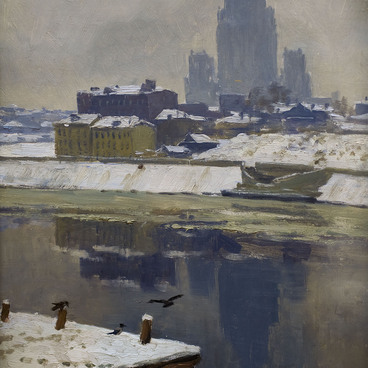The work ‘Still life with marrow, ” kept in the Valuy Museum of History and Art, was created by local artist Vasily Bocharnikov.
The future artist was born in 1927 in the town of Valuyki. Even in his early childhood, Bocharnikov always took pencils with him to draw nature. He made various pictures and wrote poems for them.
An acquaintance in the late 1940s was necessary for the development of Vasily Bocharnikov as an artist.
Bocharnikov started painting professionally in oil in 1964. Twenty years later, he graduated from the People’s University of Arts in Moscow. In the center of his works’ narration was mainly his hometown of Valuyki, its ancient history, and its first settlers. On these themes, he created numerous still lifes, landscapes, and sketches.
The artist’s canvas, ‘Still life with Marrow, ” is an autumn still life in a warm color scheme made up of ripe fruit. In the foreground of the painting, he placed a small turquoise-light blue table on which he set various gifts. The first thing that catches the viewer’s eye is a basket with a pile of apples, which occupies most of the canvas.
Near the basket with apples in a vertical rack, Bocharnikov depicted the center and main focus of the picture — a marrow, which forms the upper corner of the composition. To the right of it is a glass decanter with berry juice. Flaming clusters of guelder rose placed in front of the decanter attracts the viewer’s attention. So the master conveyed a high mood against the background of the coming autumn — this time of year has always attracted creative people.
The background of the composition is draped in dark brown fabric. With this contrast, the artist emphasized the burning colors of autumn. The picture is saturated with color: a sunny yellow-red pile of juicy apples, the heat of guelder rose clusters in bright green leaves. The contrast technique used by Bocharnikov gives extra brisk to the canvas, while the painting’s tone remained restrained.
The future artist was born in 1927 in the town of Valuyki. Even in his early childhood, Bocharnikov always took pencils with him to draw nature. He made various pictures and wrote poems for them.
An acquaintance in the late 1940s was necessary for the development of Vasily Bocharnikov as an artist.
During this period, he served in the army in Donetsk, and his military unit restored the railway station building. Sculptors were needed to make sculptures and wall bas-reliefs, and Bocharnikov began to master a new profession. All the soldiers took a short course in modeling, after which Vasily Bocharnikov sculpted an ancient Greek goddess, which he remembered from childhood.
Bocharnikov started painting professionally in oil in 1964. Twenty years later, he graduated from the People’s University of Arts in Moscow. In the center of his works’ narration was mainly his hometown of Valuyki, its ancient history, and its first settlers. On these themes, he created numerous still lifes, landscapes, and sketches.
The artist’s canvas, ‘Still life with Marrow, ” is an autumn still life in a warm color scheme made up of ripe fruit. In the foreground of the painting, he placed a small turquoise-light blue table on which he set various gifts. The first thing that catches the viewer’s eye is a basket with a pile of apples, which occupies most of the canvas.
Near the basket with apples in a vertical rack, Bocharnikov depicted the center and main focus of the picture — a marrow, which forms the upper corner of the composition. To the right of it is a glass decanter with berry juice. Flaming clusters of guelder rose placed in front of the decanter attracts the viewer’s attention. So the master conveyed a high mood against the background of the coming autumn — this time of year has always attracted creative people.
The background of the composition is draped in dark brown fabric. With this contrast, the artist emphasized the burning colors of autumn. The picture is saturated with color: a sunny yellow-red pile of juicy apples, the heat of guelder rose clusters in bright green leaves. The contrast technique used by Bocharnikov gives extra brisk to the canvas, while the painting’s tone remained restrained.


